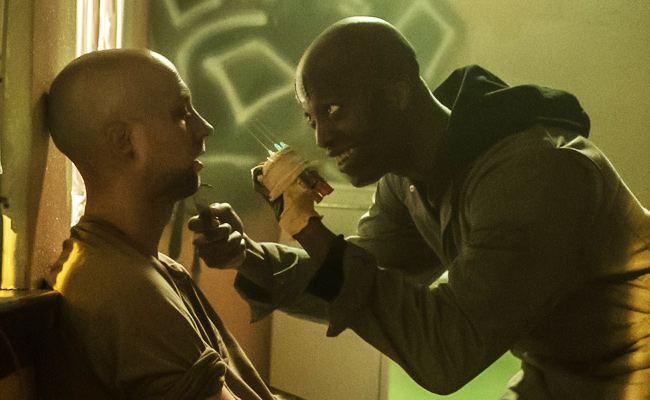
Aptly, The First Purge was to be my first purge movie. I hadn’t seen the others, partly through happenstance and partly through not caring enough to seek them out. I figured that since this one was an origin story, I could get all caught up in one fell swoop. I’d never sought them out before, because the idea of crime being legal once a year as a way to reduce crime felt more like a facsimile of satire than actual satire. The whole thing felt a little like an excuse for jump-scares and Halloween masks, and the ads were full of American flag imagery, which is often the easiest way to telegraph social commentary without actually doing any.
After The First Purge, I can’t tell if The Purge franchise has accidentally stumbled into relevance or if I was just wrong about it all along. It still has the scary masks and jump-scares, but whether through its creators’ cleverness or current events, it is now disturbing on a much deeper level. The social commentary no longer feels like fake sloganeering.
In a local news montage at the outset, we learn that the American people have gotten so fed up with the way things are (ie, crime and income inequality, the chief complaints of the right and the left, respectively) that many have turned to a reactionary new political party, “The New Founding Fathers Of America,” who are endorsed by the NRA and whose newly sworn-in president promises to resurrect the American Dream and “help Americans start dreaming again.”
As part of this initiative, they’ve enlisted the help of a psychologist played by Marisa Tomei (aka “The Architect,” aka Dr. Updale, which I can’t hear or type without thinking of Updog), who thinks this whole purging idea will be a cathartic exercise full of “freeing violence” and ultimately good for our national mental health. But is she the brains of this operation, or just the NFFA’s dupe?
The pilot purge is slated to take place on a cordoned-off Staten Island (an homage to Escape From New York, et al), and our main characters become the people who live there — drug kingpin Dmitri (played by Insecure love interest Y’lan Noel), activist Nya (Lex Scott Davis), Nya’s impressionable brother Isaiah (Joivan Wade), and a ghoulish, green-toothed crack head named “Skeletor” (Romiti Paul), who tells a psychologist that he likes to “fuck my lungs with smog” in his pre-purge medical screening.
The Skeletor character feels like a holdover from The Purge‘s schlock roots, a spooky slasher movie stereotype, but the idea of a government run by embittered reactionaries pushing through lethal experiments on poor people feels eerily relevant. When someone asks Dmitri why he, a guy who makes his living doing illegal things, doesn’t like the idea of legalized crime, he says “I don’t like it because I haven’t seen it. I don’t know how to control it,” or something to that effect.
That’s sort of The First Purge in a nutshell — this mature, relevant fear of the chaotic and the unknown tied to political upheaval, which then has to coexist with the old “scary green-toothed guy with a knife” fears. At its best, it depicts the latter as the smokescreen for the former, a government distracting you with a crazy crackhead while it paves the way for exterminating poor people. This is… not something I expected from a co-production of Michael Bay’s Platinum Dunes.
Even the way the purge manifests itself on the street hits close to home. During the purge, there’s a moment when Nya and Isaiah are trying to get home and they get waylaid by a purger in a scary mask holding a gun. He lines them against the wall with the gun to their head. What does he want? To rob them? Kill them for fun? Rape them? Enslave them? The fact that he ultimately squirts them with water (surprise! he was just trying to scare them! Are you triggered?) doesn’t make the scene any less scary.
The root fear the purge engenders is the fear that you and the people around you lack a basic shared humanity. The fact that that feels so relevant these days is much scarier than the scarred up knife-wielding crackhead. Wanting to fuck your lungs with smog feels logical compared to the squirt gun guys who seem so prevalent. In so many ways society is built on a foundation of predictability. That center line in the street isn’t a wall, it’s just a line. We’re relying on each others’ instinct for self-preservation, and our own assumption of their instinct for self-preservation, to keep us safe. The root fear of The First Purge is in stripping away the ability to discern strangers’ motives. And the fact that a schlocky movie full of glowing eyeballs (oh, the government has also given the people cameras in their contact lenses to monitor the purge, which makes their eyes glow like wolves) is able to tap into that is pretty much the definition of Manny Farber’s old take on “termite art.”
Still, The First Purge‘s ability to build this relevant premise, where reactionaries are demonizing the poor (as personified by an actual demon in Skeletor) in order to exterminate them, isn’t quite matched by their ability to resolve the conflict. They essentially turn one character into Rambo and stage a shoot ’em up. And so this incredibly perceptive social commentary often coexists with ham-fisted shlock (such as in one scene where the metaphor is made abundantly clear when a purger assaults Nya and she kicks him in the face calling him a “pussy-grabbing motherfucker”). That’s not entirely a bad thing, and I sure as hell didn’t see it coming.






